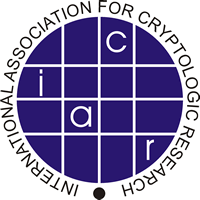eprint.iacr.org/2014/610
Preview meta tags from the eprint.iacr.org website.
Linked Hostnames
5- 23 links toeprint.iacr.org
- 1 link tocreativecommons.org
- 1 link toia.cr
- 1 link toiacr.org
- 1 link towww.iacr.org
Thumbnail

Search Engine Appearance
Computing on the Edge of Chaos: Structure and Randomness in Encrypted Computation
This survey, aimed mainly at mathematicians rather than practitioners, covers recent developments in homomorphic encryption (computing on encrypted data) and program obfuscation (generating encrypted but functional programs). Current schemes for encrypted computation all use essentially the same "noisy" approach: they encrypt via a noisy encoding of the message, they decrypt using an "approximate" ring homomorphism, and in between they employ techniques to carefully control the noise as computations are performed. This noisy approach uses a delicate balance between structure and randomness: structure that allows correct computation despite the randomness of the encryption, and randomness that maintains privacy against the adversary despite the structure. While the noisy approach "works", we need new techniques and insights, both to improve efficiency and to better understand encrypted computation conceptually.
Bing
Computing on the Edge of Chaos: Structure and Randomness in Encrypted Computation
This survey, aimed mainly at mathematicians rather than practitioners, covers recent developments in homomorphic encryption (computing on encrypted data) and program obfuscation (generating encrypted but functional programs). Current schemes for encrypted computation all use essentially the same "noisy" approach: they encrypt via a noisy encoding of the message, they decrypt using an "approximate" ring homomorphism, and in between they employ techniques to carefully control the noise as computations are performed. This noisy approach uses a delicate balance between structure and randomness: structure that allows correct computation despite the randomness of the encryption, and randomness that maintains privacy against the adversary despite the structure. While the noisy approach "works", we need new techniques and insights, both to improve efficiency and to better understand encrypted computation conceptually.
DuckDuckGo
Computing on the Edge of Chaos: Structure and Randomness in Encrypted Computation
This survey, aimed mainly at mathematicians rather than practitioners, covers recent developments in homomorphic encryption (computing on encrypted data) and program obfuscation (generating encrypted but functional programs). Current schemes for encrypted computation all use essentially the same "noisy" approach: they encrypt via a noisy encoding of the message, they decrypt using an "approximate" ring homomorphism, and in between they employ techniques to carefully control the noise as computations are performed. This noisy approach uses a delicate balance between structure and randomness: structure that allows correct computation despite the randomness of the encryption, and randomness that maintains privacy against the adversary despite the structure. While the noisy approach "works", we need new techniques and insights, both to improve efficiency and to better understand encrypted computation conceptually.
General Meta Tags
14- titleComputing on the Edge of Chaos: Structure and Randomness in Encrypted Computation
- charsetutf-8
- viewportwidth=device-width, initial-scale=1, shrink-to-fit=no
- citation_titleComputing on the Edge of Chaos: Structure and Randomness in Encrypted Computation
- citation_authorCraig Gentry
Open Graph Meta Tags
7- og:imagehttps://eprint.iacr.org/img/iacrlogo.png
- og:image:altIACR logo
- og:urlhttps://eprint.iacr.org/2014/610
- og:site_nameIACR Cryptology ePrint Archive
- og:typearticle
Link Tags
4- apple-touch-icon/img/apple-touch-icon-180x180.png
- shortcut icon/favicon.ico
- stylesheet/css/dist/css/bootstrap.min.css
- stylesheet/css/eprint.css?v=10
Links
27- https://creativecommons.org/licenses/by/4.0
- https://eprint.iacr.org
- https://eprint.iacr.org/2014/610.pdf
- https://eprint.iacr.org/about.html
- https://eprint.iacr.org/byyear